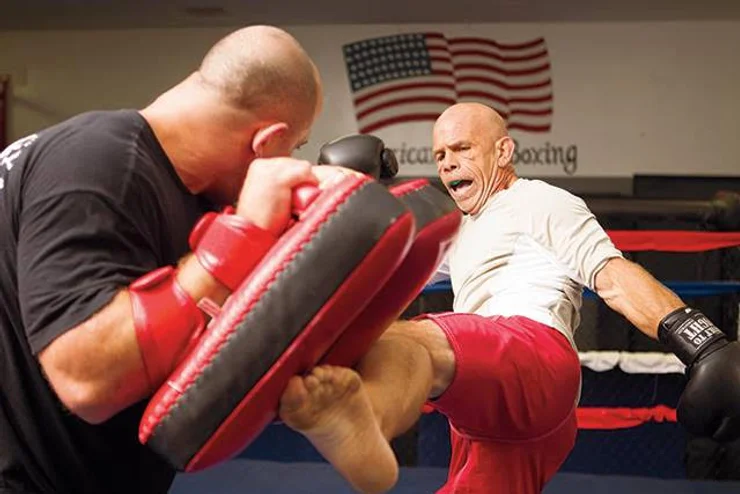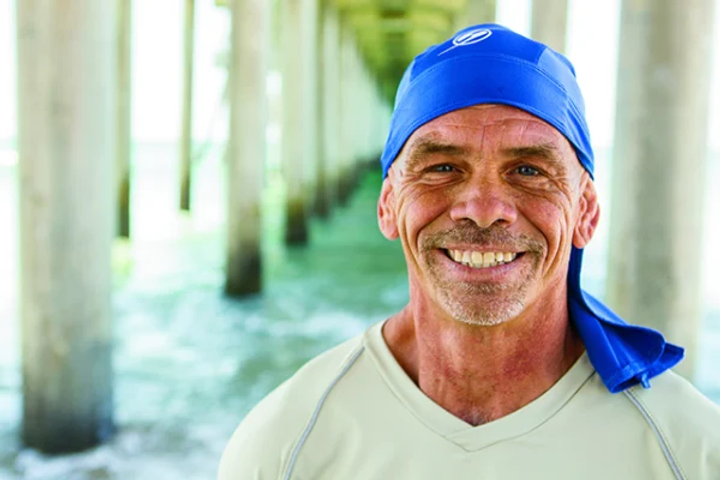
The raw, violent yelps are turning heads at the American Gym in Costa Mesa. Students crunching through the warm-ups of their cardio boxing class can’t ignore the bald-headed man making noise in the ring. The wiry 5-foot-7, 150-pound figure uncoils another explosive kick. His bare foot smacks the sparring pads of his towering trainer and he grunts out a shrill bark like an unchained junkyard dog.
The obvious question on everyone’s minds: Who is this guy?
His name is Tom Jones but answering that question is anything but simple. He’s reached endurance peaks of four separate sports—karate, Muay Thai kickboxing, marathon running, and marathon paddling. He doesn’t fit the career mold. Try using labels to describe Jones and you’ll need a lot of hyphens. Would champion-extreme-enviro-athlete-activist-speaker work?
We’ll stick with professional anomaly.
Jones’s SUP roots pre-date the sport (2006), with Laird Hamilton, the progenitor himself, providing a personal introduction. Hamilton honored the impassioned request for paddleboard instruction from the Huntington Beach prizefighter who’d run 121 consecutive marathons in a Forrest Gump-like odyssey across the U.S. in 2000.
Hamilton suggested Jones use standup to tackle distance challenges, noticing his pension for pain the first time they paddled together in Maui’s Maliko Bay: “He will not give up,” Hamilton says. “And his cardiovascular capacity is outstanding. Couple the two and you have your hands full with Tom.”
Despite high-profile connections, Jones has operated largely on the popular periphery. In 2007 he paddled 1,250 miles over 90 days down the entire California coastline; in 2010, 1,507 miles over 93 days up the East Coast from Key West to New York City; then 2012, 520 miles in 15 days around Virginia’s Smith Mountain Lake. Yet the standup spotlight still bobs and weaves around Jones, unsure how to cast this endurance niche.
“I’m a different animal,” he explains as he steps from the ring to the outdoor weight room where he begins a series of curls and presses while standing on a balance board. “First of all, I’m a tortoise, not a hare. And secondly, I decided after I’d won my seventh title in the ring that I’d only use my athletic abilities to champion worthwhile causes for charity. There’s no more ‘About me,’ I got a wall full of belts.”
He’s not puffing his chest when he says this. He’s simply stating fact with an unwavering ice-blue stare. Jones talks like he types, IN ALL CAPS, and his intense, candid energy spills over in a chain of tales and lessons from his unbelievable life story.
You have no choice but to listen. He’s telling you about the time he kicked Chuck Norris—an early mentor, friend and sparring partner—in the head. CHUCK NORRIS.

The tales engage listeners in the gym, making it easy to understand Jones’ success as a motivational speaker, especially when it comes to rallying support for his next, seemingly impossible project. In May 2015, at age 52, the divorced father of three will attempt to standup paddle from San Francisco to Oahu. Like his other ocean expeditions, Jones will rely on nightly support. Instead of an RV chasing him along a coastline, he’ll have a 50-foot sailing catamaran captained by Charles Moore, credited for discovering the Great Pacific Garbage Patch. Jones chartered Moore’s Oceanographic Research Vessel Alguita for 120 days. That means he must average 20 miles a day for four months to cover the 2,400 miles.
“I’m looking for that no-one’s-ever-done-before thing,” Jones says. “Because if I can get the wow factor, I get that 15 to 18 seconds of your undivided attention.”
In that time, Jones hopes to deliver a message about our “addiction to single-use plastics” and the degradation of our oceans to an impressionable younger generation. While Jones plods away on his custom, 17.5-foot board, Captain Moore will be continuing his research on plastic debris, reconvening at day’s end and live-streaming broadcasts of their findings and progress to classrooms twice a week.
Really though, the ship is a vessel for another kind of message. It’s one that Jones had to figure out the hard way. At age 10, after a childhood of abuse, Jones was put in Covina, California’s Masonic Children’s Home, which he says was “full of pedophiles” and where he trusted no one. With a sixth grade education, he fought in the ring out of necessity, eventually finding a positive role model in Norris, (whom he met at a karate tournament when he was 19). Norris took the troubled karate prodigy under his wing, putting him to work as his training partner and bodyguard in the late ‘80s.
By the time Jones met Laird—having begun his transition from fighting for survival to fighting for causes—Jones still had no idea what aloha meant.
“Laird says, ‘You don’t know what the aloha spirit is? It’s sharing ideas and helping each other out and loving each other,” recalls Jones, laughing. “I go, ‘Cool, let’s do the aloha spirit!’”
Jones and Hamilton are still sharing ideas, now working on the final design tweaks (beaked nose, interchangeable ama outrigger, foot rudder) of an innovative board capable of an ocean crossing. And they still train together. “He drives the train,” Hamilton says of the workouts where he helps incorporate dynamic elements like underwater resistance routines and yoga into Jones’ daily workout regime that includes a 10-mile morning run and 10-mile evening paddle. Jones still hits the bags and trades texts with Norris about the latest ‘Chuck Norris Jokes’ all while refining that broader message of positive determination.
“It was Chuck Norris who taught me that the most successful people in life are the people who can help people,” Jones tells me as we exit the gym.
We’ve been talking nonstop for three hours, pausing only when he had his mouthguard in for sparring. It’s hard not to feel uplifted, or to doubt that Jones will achieve his pan-Pacific objective.
Before he climbs into his truck, with a 14-foot board racked above a bed loaded with his workout-ready tractor tire and tethered railroad tie, the man of so many words turns back with one last thought:
“ALOHA,” he says.
Note: Article originally published here: